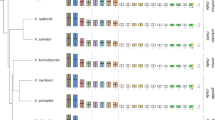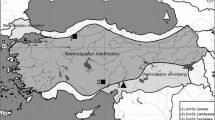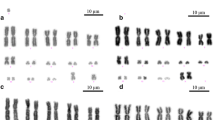Abstract
The karyotype and meiotic phases of Lemniscomys barbarus from Morocco were extensively studied with G- and C-banding, Ag-NOR and fluorochrome staining, in situ hybridization with an rDNA probe, and synaptonemal complex analysis. Comparison of the data with those previously published for an Algerian specimen revealed in the Moroccan specimens the presence of large heterochromatic segments in the sex chromosomes, a new nucleolar organizer at chromosome pair 1, and silent NORs on both sex chromosomes — features that are not present in the Algerian specimen. These findings demonstrate that during the very recent evolution of the karyotype of this species a new NOR was acquired by pair 1, possibly by amplification of ribosomal genes after a translocation event. This new NOR changed the preference of activatio n of the NORs in these individuals and became the preferentially activated NOR. Another autosome—sex chromosome translocation led to the presence of NORs on the sex chromosomes, which were then inactivated by the invasion of repetitive sequences. These silent NORs may be involved in the pairing of the two sex chromosomes.
Similar content being viewed by others
References
Burgos M, Jiménez R, Díaz de la Guardia R (1986) A rapid, simple and reliable combined method for G-banding mammalian and human chromosomes. Stain Technol 61: 257–260.
Filippucci MG, Civitelli MV, Capanna E (1986) The chromosomes of Lemniscomys barbarus (Rodentia, Muridae). Boll Zool 53: 355–358.
Jiménez R, Burgos M, Sánchez A, Díaz de la Guardia R (1990) Synaptonemal complex analysis of spermatocytes from Talpa occidentalis (Insectivora, Mammalia). The autosomal synapsis and the substaging of cygonema and pachynema. Cytogenet Cell Genet 53: 97–102.
Marshall-Graves JA (1995) The origin and function of the mammalian Y chromosome and Y-borne genes. An evolving understanding. Bioassays 17: 311–320.
Matthey R (1954) Nouvelles recherches sur les chromosomes des Muridae. Caryologia 6: 1–44.
Matthey R (1959) Formules chromosomiques de Muridae et de Spalacidae. La question du polimorphisme chromosomique chez les mamifères. Revue Suisse Zool 66: 175–209.
McKee BD, Habera L, Vrana JA (1992) Evidence that intergenic spacer repeats of Drosophila melanogaster rRNA genes function as XY pairing sites in male meiosis, and a general model for achiasmatic pairing. Genetics 132: 529–544.
Merry DE, Pathak S, Vandeberg JL (1983) Differential NOR activities in somatic and germ cells of Monodelphis domestica (Marsupialia, Mammalia). Cytogenet Cell Genet 35: 244–251.
Rice WR (1996) Evolution of the Y-sex-chromosome in animals. Bioscience 46: 331–343.
Rufas JS, Iturra P, De Souza W, Esponda P (1982) Simple silver staining procedure for the localization of nucleolus and nucleolar organizer under light and electron microscopy. Arch Biol 93: 267–276.
Sánchez A, Burgos M, Jiménez R, Díaz de la Guardia R (1989) Quantitative analysis of NOR-Ag-staining in Eliomys quercinus. Genome 32: 978–982.
Sánchez A, Burgos M, Jiménez R, Díaz de la Guardia R (1990) Variable conservation of NORs during karyotypic evolution in Microtidae. Genome 33: 119–122.
Schweizer D (1981) Counterstain-enhanced chromosome banding. Hum Genet 57: 1–14.
Schweizer D, Mendelak M, White MJD, Contreras N (1983) Cytogenetics of the parthenogenetic grasshopper Warramaba virgo and its bisexual relatives. X. Patterns of fluorescence banding. Chromosoma 88: 227-236.
Sumner AT (1972) A simple technique for demonstrating centromeric heterochromatin. Expl Cell Res 75: 304–306.
Van der Straeten E, Verheyen WN (1978) Karyological and morphological comparisons of Lemniscomys striatus (Linnaeus, 1758) and Lemniscomys bellieri (Van der Straeten, 1975) from Ivory Coast (Mammalia: Muridae). Bull Carnegie Museum 6: 41–47.
Viegas-Pequignot E, Petit D, Benazzou T et al. (1986) Phylogenie chromosomique chez les Sciuridae, Gerbillidae et Muridae, et étude d'èspeces appartenant a d'autres familles de Rongeurs. Mammalia 50: 164–202.
Wahl GM, Vitto L, Rubnitz J (1983) Co-amplification of rRNA vgenes with CAD genes in N-(phosphonacetyl)-L-aspartateresistant Syrian hamster cells. Mol Cell Biol 3: 2066–2075.
Weisblum B (1973) Why centric regions of quinacrine treated mouse chromosomes show diminished fluorescence. Nature 246: 150–151.
Author information
Authors and Affiliations
Rights and permissions
About this article
Cite this article
Stitou, S., Burgos, M., Zurita, F. et al. Recent evolution of NOR-bearing and sex chromosomes of the North African rodent Lemniscomys barbarus. Chromosome Res 5, 481–485 (1997). https://doi.org/10.1023/A:1018473131446
Issue Date:
DOI: https://doi.org/10.1023/A:1018473131446




